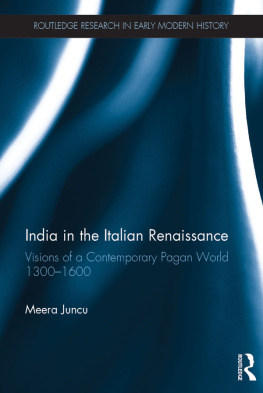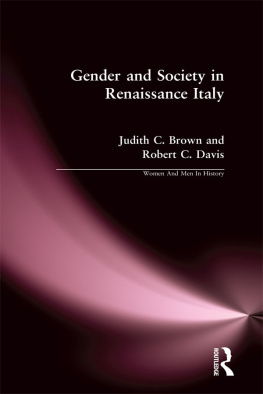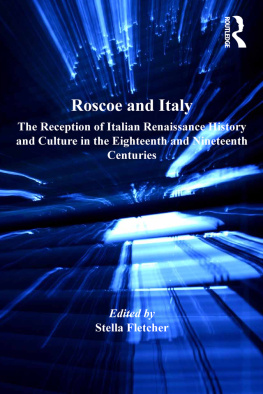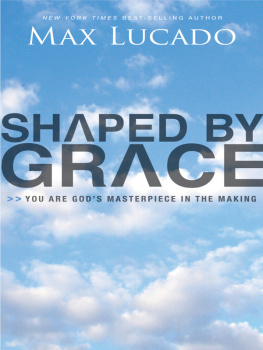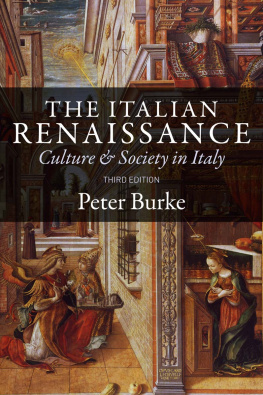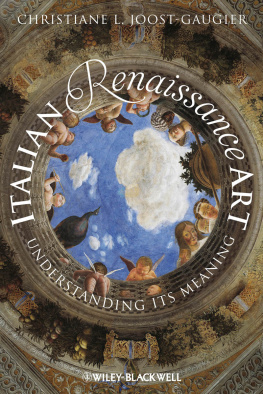Jacket/Cover Design: Pamela L. Schnitter
LIST OF ILLUSTRATIONS
) Francesco del Cossa, Allegory of April, ca. 1469
Domenico di Paris, Fides, ca. 1467
Domenico di Paris, Spes, ca. 1467
) Domenico di Paris, Caritas, ca. 1467
) Raffaello Sanzio, called Raphael, Portrait of Baldassare Castiglione, ca. 15141515
) Raphael, The Three Graces, ca. 15041505
) Raphael, Study for the Three Graces, ca. 15171518
Raphael, Venus, ca. 15111514
) Raphael, La Fornarina, 15181519
) Raphael and workshop, Wedding Banquet of Cupid and Psyche (detail), 15181519
Francesco del Cossa, Allegory of April (detail), ca. 1469
Anonymous, Emblem with bees, 1516
Lucas Cranach the Elder, The Honey Thief, ca. 15261527
Andrea Alciati, Dulcia quandoque amara fiera, 1531
Andrea Alciati, Ex bello pax, 1531
Alfonso dEste personal coin, De forti dulcedo, ca. 1505
Anonymous, Image of Ewe Suckling Wolf-Cub, 1532
) Michelangelo Buonarroti, Piet, 1499
) Michelangelo Buonarroti, Cristo di Santa Maria sopra la Minerva, 15191520
Anonymous, Laocon Group, ca. 4220 BC
Michelangelo Buonarroti, Colonna Piet, ca. 1538
Michelangelo Buonarroti, Colonna Crucifixion, ca. 1538
ACKNOWLEDGMENTS
IT IS A PLEASURE TO acknowledge the bounteous help I have received in the making of this book. Debts of multiple kinds were accumulated at Durham University, where my project ended and began; at the University of Birmingham, where I worked for over a decade; and in Oxford, where I lived during the Birmingham years. Special thanks for conversation, ideas, practical support, and friendship are owed to Daniele Albertazzi, Judith Allan, Clelia Boscolo, Clodagh Brook, Ben Cairns, Carlo Caruso, Rachael Dann, Paolo de Ventura, Stephen Forcer, Finn Fordham, Heather Hamill, Sean Hand, Nigel Harris, David Hemsoll, Alice Hunt, Sarah Knott, Roman Krznaric, Francesco Manzini, James McConnachie, Richard Parish, Kate Raworth, Charlotte Ross, Julia Shillingford, Kate Tunstall, Alain Viala, Annette Volfing, and Caroline Warman. Without Simon Travis, this book would almost certainly not have been written.
Collaborative research groups nourished the project during its gestation. For creating havens of collegial debate, I thank Terence Cave (director of the Oxford-based, Balzan-funded project Literature as an Object of Knowledge); Alex Marr (director of the European Research Councilfunded, Cambridge-based project Genius Before Romanticism); and Catherine Whistler and Ben Thomas (co-curators of the Ashmolean Museum exhibition entitled Raphael: The Drawings and engineers of a series of workshops leading up to that event). Participation in these collectives introduced me to a great many colleagues whose reflections, perspectives, and style I am indebted to, particularly the Balzanistas Kathryn Banks, Warren Boutcher, Tim Chesters, Guido Giglioni, Neil Kenny, Kirsti Sellevold, Olivia Smith, and Deirdre Wilson; and the Genius group Raphale Garrod, Richard Oosterhoff, and Jos Ramn Marcaida. Gratitude, too, to participants of the research network Early Modern Keywords, which I codirect with Richard Scholar. Our collective thinking about words and what to do with them informs this book, and I am especially thankful to Alice Brooke, Colin Burrow, Emily Butterworth, Emma Claussen, Katherine Ibbett, Michael Moriarty, Kathryn Murphy, John OBrien, Simon Park, Martino Rossi Monti, Patricia Seed, Rowan Tomlinson, and Anita Traninger.
Terence Caves Balzan project bought me out of teaching for a term in 2012; the Fondazione Giorgio Cini sponsored a residential fellowship on the island of San Giorgio Maggiore, Venice, in 2013; and the University of Birmingham provided a year of research leave in 20162017. A Leverhulme Trust Research Fellowship granted me an invaluable stretch of eighteen months (20172019) to finish writing the book. Sincere thanks to Pasquale Gagliardi, Maria Novella Benzoni, and Marta Zoppetti at the Fondazione Giorgio Cini; to Jerry Brotton for suggesting I apply to go there; and to each of my sponsors, whose generous support the book could not have done without. Durham University sponsored the purchase of permissions and publication rights for the images, for which I am grateful.
Archivists and librarians helped in the research process. I am particularly grateful to Martin Killeen of the Cadbury Research Library in Birmingham; Claudia Favaron, Ilenia Maschietto, and Simone Tonin of the Manica Lunga Library at the Fondazione Giorgio Cini; Gaye Morgan at the Codrington Library in All Souls College, Oxford; and Francesca Gallori at the Biblioteca Nazionale Centrale di Firenze. Thanks, too, to the staff of the Bodleian, Taylorian, and Sackler Libraries at the University of Oxford, where I did most of my research. Ben Tate at Princeton University Press has been an engaged and supportive editor, Nathan Carr oversaw the layout and production with great care, and I am thankful, too, to Anita OBrien for scrupulous copyediting as well as to Puck Fletcher for meticulous indexing.
The Genius group, Nicol Crisafi, Jane Everson, Vittoria Falanca, Lucy Gwynn, Stefano Jossa, Neil Kenny, Maria Pavlova, Elena Porciani, Gervase Rosser, Heather Webb, and Boris Wiseman, are amongst those who invited me to give lectures in Europe and the United States during the research and writing of this book, while Abigail Brundin, Veronica Copello, Kathy Eden, Simon Gilson, Alex Marr, Martin McLaughlin, Luca DeglInnocenti, Martino Rossi Monti, Angela Scholar, Paola Ugolini, and Ben Thomas read sections or all of the book, spotting errors and providing acute insights of various kinds. Each interlocutor shaped its content and form, but all remaining errors are, of course, mine.
Deana Rankin and Wes Williams fit into a number of the categories listed above, as do Patricia Palmer and John David Rhodes, whose humour, support and inspiration enlivened all stages in the making of this book. Thanks, also, to Kathy Eden for words of wisdom delivered at key moments that provided more of a boost than she can know. Martin McLaughlin has become a friend and mentor par excellence over the years, as has Gervase Rosser. I am glad of the chance to thank them publicly for their generosity of time and wisdom. I remember, with gratitude, my first academic mentor at University College Cork, Eduardo Saccone, whose inspirational teaching of Ariosto and Castiglione set me on this track in the first place.


